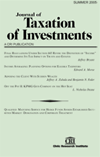Accounting and Tax Issues in Applying Tax Benefits to Corporate Investments: A Case Study
Author: António Martins.; Cristina Sá.; Daniel Taborda.
Source: Volume 38, Number 04, Summer 2021 , pp.43-62(20)

< previous article |next article > |return to table of contents
Abstract:
In 2011 and 2012 Portugal, under an external bailout and facing a drastic fall in corporate investment, enacted an investment tax credit aimed at fostering capital formation. This credit had a general principle: It should be applied to tangible assets, intangible assets, and productive biological assets related to the operating activity of corporations. A shopping center company, exploring commercial spaces and recognizing them as investment properties, sought an expansive interpretation of the law that would sustain application of the credit to investments made in 2013, because shopping centers were assets related to its operating activity. The tax authorities, based on a literal interpretation, replied that under an accounting definition of eligible assets investment properties were not included in the legal text, and denied the credit. The authors focus here—given the economic, accounting, and legal issues presented by this case—on which is the more appropriate interpretation? They maintain that Article 10 of the Portuguese tax benefit law, allowing expansive interpretation, makes the tax authorities’ position highly questionable. On a policy implication level, they highlight complexities arising from the fact that economic life is richer than accounting formulations, especially in a sensitive area like tax benefits for investment, a crucial component of economic growth.Keywords: tax credits; investment properties; legal interpretation; fiscal policy; Portugese tax law
Affiliations:
1: University of Coimbra; 2: Polytechnic of Leiria; 3: University of Coimbra.